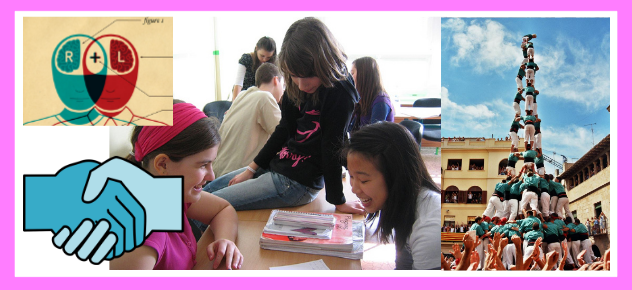

What do we mean by collaborative learning?
- Essential features of collaborative learning:
- Intentional design
- teachers use intentional structures that encourage students to learn in groups
- Equitable engagement / co-laboring
- all group members are actively engaged and provide meaningful contributions to the learning task(s)
- Meaningful learning
- students working in groups deepen their understanding of course objectives
- Intentional design
What is the difference between collaborative learning and cooperative learning?
- Cooperative learning:
- students cooperate to achieve a common goal / task
- teacher retains traditional role of subject matter expert
- often students are striving toward single correct answer or best solution known by teacher
- emphasizes cooperative and harmony among group members
- Collaborative learning:
- based in social constructivism, knowledge is constructed by the development of a consensus among members of a group that includes students and teacher
- teacher, along with students, is a member of a learning community that is co-constructing knowledge
- unlike cooperative learning which emphasizes harmony, members of groups may engage in debate and dissent prior to achieving consensus
- group work addresses questions with ambiguous answers – answers are subject to doubt and must be backed by judgements grounded in evidence
Formal, informal, abd base groups:
- Formal groups:
- work together for the duration of a learning task which may last from one class period to several weeks
- accomplish shared goals, utilize varied strengths of team members, maximize learning for all
- Informal groups:
- temporary groups that last for one discussion or one class period
- Base groups:
- long-term groups with stable membership
- aimed at providing long term support and sense of belonging to members
Five Essential Elements of Cooperative Learning Groups:
- Positive interdependence:
- success of individuals and the group are intertwined
- Promotive interaction
- students are expected to actively support each other by sharing knowledge, skills and resources
- Individual and group accountability:
- students are assessed individually and and as a group
- each member is held accountable to group goals
- Development of teamwork skills:
- students are taught content AND collaboration skills
- Group processing:
- group members reflect on their how they are collaborating and plan next steps to improve their teamwork
What is the pedagogical rationale for collaborative learning?
- Some Benefits of Collaborative Learning:
- prepares students for teamwork that occurs in future careers
- actively involves students in learning
- helps students appreciate diversity of perspectives
- honors and utilizes individuals’ past academic / life experiences
- Connection to Research:
- Neurological:
- students build their brains (develop more neurological pathways) as they interact with other people and ideas
- Cognitive:
- students learn by developing schemata – networks of connected bits of information
- what students are able to learn is highly dependent on what they already know (current schemata)
- active ideas (as opposed to ideas) are well integrated into schemata and can be related to new and old ideas and problems
- Social:
- zone of proximal development – what students are able to do with the assistance of teachers or more capable peers
- Neurological:
What is the evidence that collaborative learning promotes and improves learning?
- a lot of research has shown that college students grow more and are more successful when they interact with faculty and peers in / our of classroom on academic work
- one of the most effective methods of instruction is students teaching other students
- research has shown success with collaborative learning techniques over a variety of grade levels and subjects
- cooperative learning arrangements have been shown to be more effective than competitive and individualistic structures – leads to better solutions, better transfer of knowledge, higher levels of reasoning and higher achievement
- research has shown that cooperative learning seems to have best impact when groups are recognized based on the individual learnings of members

Collaborative learning techniques help build students’ collaborative skills and help students deepen their knowledge with the assistance of their collaborative partners. Collaborative learning experiences are “deliberately” designed to promote deeper learning, group/individual accountability, group processing, and active and equitable contributions of group members. The 5 essential elements of collaborative learning (see above) can be used to design, evaluate, and optimize collaborative learning experiences.

Preparation Steps
- Research and design activities that promote the 5 essential elements of collaborative learning
- Evaluate past collaborative scaffolding using the 5 essential element of collaborative learning – use this assessment to improve scaffolding
Early Implementation Steps
- Implement scaffolding that teaches students the 5 essential element of collaborative learning and gives them practice / reflection opportunities
- Design learning experiences that use collaboration to build content skills.
- Give students opportunities to reflect on how their group processes are helping or detracting from learning and plan groups’ next steps
Advanced Implementation Steps
- Establish routines that promote 5 essential elements of collaborative learning
- Provide regular opportunities throughout projects for students to give, receive and reflect upon collaborative feedback from their teammates. Guide students to use this feedback to improve their collaboration skills.

- Collaboration articles

 Chapter 1 from
Chapter 1 from